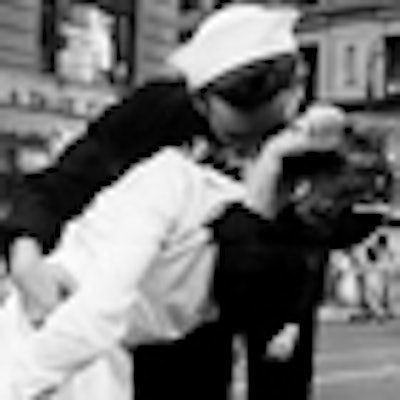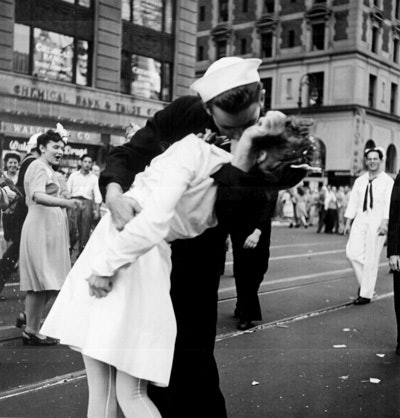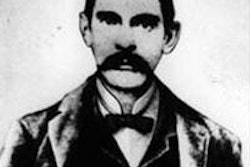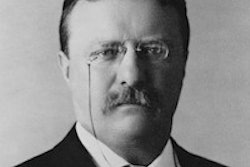
Few pictures in history are as enigmatic as the 1945 photo depicting a sailor kissing a nurse in New York's Times Square. The picture was taken on V-J Day -- Victory over Japan Day, the official end of World War II. For nearly 70 years, the girl in the picture was always presumed to be a nurse. Taken by Alfred Eisenstaedt, the father of photojournalism, the photo was an impromptu affair.
 |
| Photographer Alfred Eisenstaedt is credited with the famous photo that appeared in Life magazine, "V-J day in Times Square." But this version, "Kissing the War Goodbye," was taken at the same time from a slightly different angle by Navy photo journalist Lt. Victor Jorgensen and published in the New York Times. |
Eisenstaedt never got the couple's names. The photo became his best known and one of the most famous ever taken. It isolated in time the joy and ecstasy experienced when the war ended. It was taken on August 14, 1945. Just seven days earlier the world's first atomic bomb had devastated Hiroshima, with a second bomb dropped on Nagasaki two days later. They were the one-two punch that preceded Japan's unconditional surrender.
The picture published in August 1945 was one of four frames Eisenstaedt took over the span of a few seconds. The sequence is described in the recently published book, The Kissing Sailor (Annapolis: Naval Institute Press, 2012): "As he overtook her slender frame ... he pulled her inward toward his lean and muscular body." Her initial attempt to resist "proved futile against the dark-uniformed man's strong hold." She instinctively clenched her fist and lifted her arm up in defense. The two embraced; the next frame showed "a mixture of brutish force, caring embrace, and awkward hesitation."Finally she lowered her left arm "and gave over to her pursuer -- but only for three or four seconds." And then it was over. The two parted, not realizing their encounter had been photographed, let alone immortalized for all time.
Decades-long mystery
As time evolved, the mystery of who the photo's characters were magnified the importance of the picture. Originally, it had been one of scores published in the August 1945 edition of Life magazine celebrating the war's end. The question of who the couple was became as much a part of the enigma as the photo itself. Over the decades, Life attempted to locate the original characters in the picture, and several candidates came forward. At various times Eisenstaedt, Life, other publications, and several prominent newsmen all declared they had found the elusive couple, but none had.
But with the publication of their exhaustive forensic study, The Kissing Sailor, in 2012, authors Lawrence Verria and George Galdorisi irrevocably proved that George Mendonsa and Greta (Zimmer) Friedman were, in fact, the kissing couple.
George Mendonsa, 22, was from Rhode Island -- a fisherman in civilian life. He had enlisted in 1942, rising to quartermaster and petty officer, first class on The Sullivans, a naval destroyer. He was on a 36-day leave from the ship, which was docked in San Francisco. On this, his last day of shore leave, he had taken his girlfriend Rita (later wife of 66 years) to the movies at Radio City Music Hall before heading back to San Francisco. Shortly after the movie started, an employee announced to the audience that the war had ended. The theater emptied, and George and Rita walked toward Times Square, taking liberal advantage of the celebratory liquor being offered by bars along the way.
Realizing his combat days were over, an exuberant George began grabbing and kissing various ladies along the way. "Arguably, more people kissed on that day than on any other in history," Verria and Galdorisi wrote.
The dental assistant
Several blocks away, Greta Zimmer, a 25-five-year-old dental technician on her lunch break, walked toward Times Square. She wanted to see the scrolling news ticker on the New York Times building in Times Square to confirm that the war was really over. "The war had rained more than a fair share of misery upon Greta," the authors wrote.
In 1939, Greta and a sister had been forcibly moved to New York by her Austrian parents to live with relatives. A third sister was moved to British Palestine. The Zimmers were Jews. Six months later, Greta's parents were taken to Auschwitz by the Nazis, and they didn't survive the war. During the war, Greta volunteered as an air raid warden while she studied fashion in school. She wanted to be a fashion designer.
In early 1945, she took a job as a dental assistant in Manhattan. She had worked there several months and, as was customary of the times, she wore a uniform similar to a nurse: white dress, white stockings, white shoes, and white cap. As a dental assistant, she cleaned teeth and prepared patients for fillings and extractions. Her employer's office -- Dr. J. L. Berke -- was a short six-block walk to Times Square.
Neither Greta nor George realized their kiss had been photographed that fateful day. Neither saw the picture in Life magazine. Greta's first glimpse of the photo was some 20-odd years later when she flipped through a book of Eisenstaedt's work. She finally made her claim to fame in 1980 when Life magazine held a contest to determine the real couple. Several candidates emerged -- including Greta and George -- and several were declared the real couple. It was left to Verria and Galdorisi in The Kissing Sailor to prove the couple was George and Greta.
Unique details
A "mountain of evidence" supported their conclusion, according to the authors. Scientists using modern technology such as facial recognition, forensic anthropology, and detailed photographic analysis evaluated the picture. In the end, nose and hand size, a unique hairline, an arm tattoo on the right arm, and an unusual bend in the thumb all led to the conclusion that George was the "kissing sailor." In addition, he had a new uniform tailor-made while on leave and hadn't had his ratings (chevrons) sewn on, just as in the picture. Probably the clinching factor was the observance of a small lump on his arm -- barely visible -- a subcutaneous growth known medically as a "wen."
Proving Greta, the dental technician, was the "nurse" in the photo was a simple matter. Experts evaluated her slender figure, long thin legs, slender-bony fingers, and hairstyle, which they compared to the other contenders. At 5 feet 4 ¾ inches, she was the only one who could possibly fit the embrace with the 6-foot 2-inch George. Added to this was a small sliver of her "colorful tapestry purse" in one of Eisenstaedt's frames that served as the coup de gras.
In the introduction to The Kissing Sailor, the venerable newsman David Hartman sums it well, writing that the picture "makes us feel like we were there experiencing the exultation of the war's end."
Daniel Demers is a semiretired businessman whose hobby is researching and writing about 19th and 20th century historical events and personalities. He holds a bachelor's degree in history from George Washington University and a master's degree in business from Chapman University. You can review Dan's other published works at www.danieldemers.com.



















